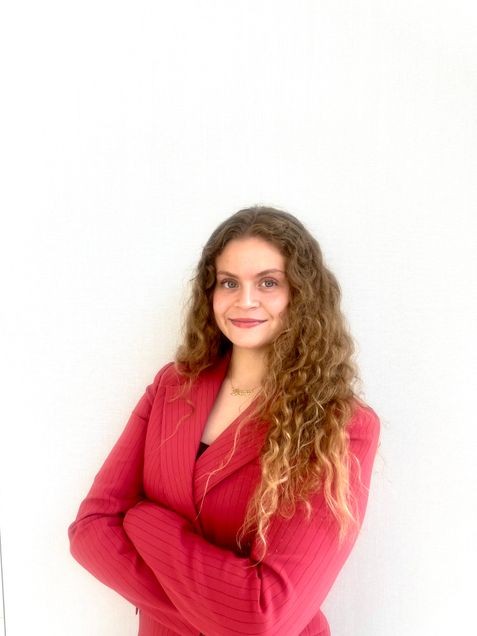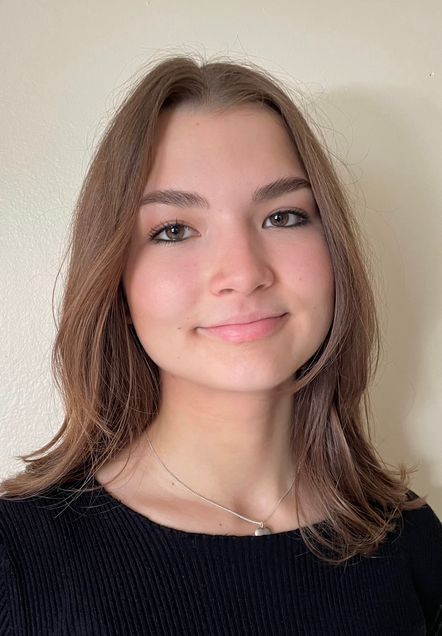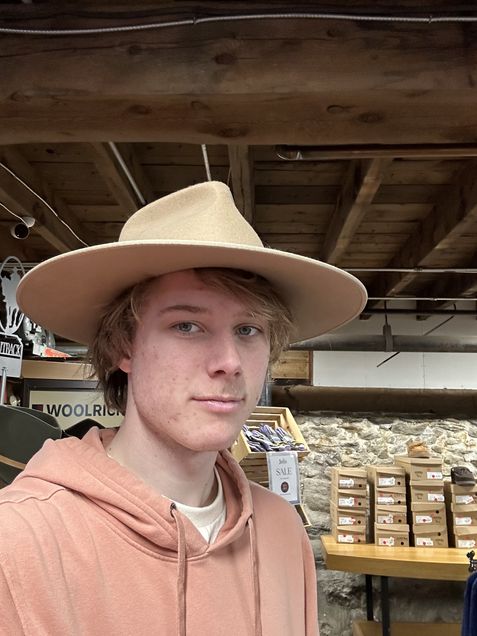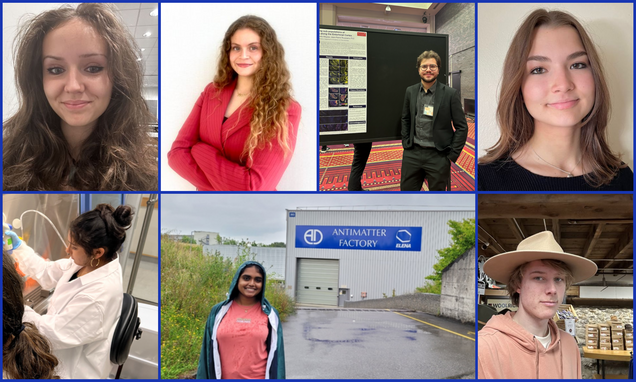Kilachand UROP Student Feature
Over the summer, UROP (Undergraduate Research Opportunities Program) and Kilachand Honors College team up to co-fund KHC students who have secured summer research positions.
In the summer of 2024, several Kilachand students were chosen for this funding opportunity. Below we feature 7 of those students, who tell us briefly about their research, how this funding impacted their research project, and advice for other students working on their research projects.
Alexia Nastasia (CAS/Pardee’27)

Can you provide us with a brief description of your summer research work?
“Mapping Worldwide Youth-Driven Initiatives for Addressing the Climate Crisis: Best Practices, Values Informing Climate Action, and Environmental Justice”
As the impacts of climate change are increasingly devastating for communities around the world, it is urgent that people of all ages and from all walks of life share ideas and have a say in the mitigation of the crisis. Young people will inherit the problems we don’t solve today, yet youth-generated solutions for addressing climate change are largely overlooked in public discourse. In awareness of this issue, my project funded by the Undergraduate Research Opportunities Program at Boston University has charted youth-led initiatives focused on environmental action globally.
Utilizing key words on various search engines online in several languages as well as information from media sources, the study has identified over 2,500 youth groups engaged in environmental action in over 200 countries. The study is unique in that it offers a comprehensive examination of the involvement of youth in creating a climate-resilient world and it has documented that young people are active in and passionate about addressing climate change everywhere on the globe, regardless of size of the nation or political system.
Study findings suggest that youth environmental groups take an array of approaches, from those that foster collaborations with existing social structures, for example with national and local governments, to those that propose new forms of social organization, for instance by taking anti-capitalist stances. Youth-led efforts also take many forms, including fieldwork for environmental revitalization, policy work for environmental stewardship planning, or protest action. Indigenous movements are an integral part of youth environmental action worldwide and environmental action is viewed by youth as part of a larger agenda including peace, justice, gender equality.
In Chile, 18-year old Sebastián Benfeld participated in a protest with 20 other young activists to denounce the environmental contamination of his home region. In Algeria, the youth-led group Together for Blue and Green passionately advocates for environmental justice, raising awareness about environmental racism. In Laos, the youth-led group Zero Waste is seeking to ensure that pollution is minimized. In Albania, several youth groups have come together to produce position papers focusing on air quality and are collaborating with the nation’s government on the implementation of the proposed actions. These are just a few examples of the many and diverse environmental initiatives launched by youth in worldwide settings that my study depicts and examines. The study results will be featured both in the form of an academic article and as a resource map online.
Please provide us with a brief statement about how you got involved with this research project – also please mention if this work is tied to your Keystone or other work through KHC.
This project idea came from my gap year between high school and college that I spent in Senegal as a participant in the U.S. Department of State’s Kennedy-Lugar YES Abroad Program, in 2022-2023. During my time abroad, I realized young people worldwide have many ideas for environmental action that are not sufficiently put to action. Upon joining BU, I discussed this issue as well as many other aspects of environmentalism with my faculty mentor, Eric Michael Kelley, and he encouraged me to put my thoughts into an UROP application.
My work is not currently tied to my Keystone because I am only a sophomore and I am still exploring ideas for my Keystone. However, I am certain I will build on my summer 2024 UROP project as well as on the environmental justice project I spearheaded during my freshman year which received funding from the Campus Climate Lab.
How did you find out about the UROP funding opportunity, how has this funding made an impact on your project (or you), and do you have any advice to students hoping to apply for this funding opportunity in the future?
I found out about UROP during the summer before my freshman year through emails received from various groups on campus and I knew right away I would like to receive UROP funding during my time at BU. I applied for spring 2024, had the project rejected but improved based on feedback, then I had my project accepted for summer 2024. I believe it is of utmost importance for Kilachand Honors College students in particular to secure funding for innovative projects that allow for the application of concepts from courses and for examining critical issues of our time. I believe I have grown as a student and emerging professional by submitting the UROP applications and subsequently by pursuing this project and I recommend the experience to incoming students. My advice for students hoping to apply for this funding opportunity in the future is to be persistent in the application process and to be as organized as possible when completing the research.
H. Zeynep Haciguzeller (ENG’25)

Can you provide us with a brief description of your summer research work?
I have been working on creating interferon-reporter gene constructs with the aim of creating an easier, quicker, and a more accurate methodology to screen in vitro RNA immunogenicity for different forms of RNA therapy at the Wilson Wong Lab.
Please provide us with a brief statement about how you got involved with this research project – also please mention if this work is tied to your Keystone or other work through KHC.
I have been a part of this lab since Fall 2023 and have worked on different projects and ideas. I got involved with this research project as my PhD mentors and PI suggested it as a potential interesting project idea and guided me to it.
How did you find out about the UROP funding opportunity, how has this funding made an impact on your project (or you), and do you have any advice to students hoping to apply for this funding opportunity in the future?
I have found out about the Engineering STARS, which I was also a part of for the summer, and UROP summer funding in an info session that was being given by BU ENG Undergraduate Programs Office. Throughout the summer, UROP offered various seminars and info sessions that have been informative about research and career and which I have found to be useful. Also, getting paid for the research you are doing feels great! For students hoping to apply in the future, I would say find a faculty member doing research that you find interesting and just go for it! Talk to them, start in their lab, inform them about this funding opportunity, and apply!
Han Kahvecioglu (ENG’25)

Can you provide us with a brief description of your summer research work?
I’ve conducted my summer research at the Nia Lab in the Biomedical Engineering department. Nia Lab focuses on understanding lung mechanics and respiratory diseases using a custom system developed: the “Crystal Ribcage”. This system allows us to observe the lung under microscope while the tissue is still alive and ventilating, in mouse models. My summer work focused on using this system to understand how inhaled aerosols are transported in the healthy and diseased lung. Further understanding this transport is important to understand how diseases change the lung environment, and have direct relevance for drug delivery applications.
Please provide us with a brief statement about how you got involved with this research project – also please mention if this work is tied to your Keystone or other work through KHC.
Knowing that I want to become a researcher in the future, I got involved in undergraduate research in my first semester at BU. Then, last year, I decided I wanted to get more experience in engineering-driven research to help determine my future field, and I joined the Nia Lab. For getting involved in the research positions I’ve had, I sent an email to the lab mentioning my passion for research, my experiences, and why their research topic interests me. I will also be conducting my engineering senior design project with this lab, which also counts towards my Kilachand Keystone Project requirement.
How did you find out about the UROP funding opportunity, how has this funding made an impact on your project (or you), and do you have any advice to students hoping to apply for this funding opportunity in the future?
I found out about UROP summer funding through their website when looking into options for staying at Boston over the summer to get some full time research experience. I’ve done research with UROP funding for two summers now, and it made great impact on my skill to be more independent in research, as a summer of full time experience is a much higher pace of growth than what I can get with my part time involvement during the semester.
Lauren Bell (ENG’26)

Can you provide us with a brief description of your summer research work?
This summer, I worked on a research project in the Teplensky Lab centered on modeling and testing a novel vaccine architecture. The lab has shown how strategic construction of a vaccine plays a huge role in determining the resulting potency of the vaccine. I harnessed this idea to make a vaccine depot that encourages and drives uniquely structured interactions between immune cells and active components (in this case, a protein). I am manipulating the number of interactions between immune cells and vaccine components, as well as the longevity of the entire system to allow for tunable drug delivery and release. This design could allow for longer-lasting vaccines that protect against a wider range of variants. I am looking forward to continuing to explore the potentials of this model going into the fall semester.
Please provide us with a brief statement about how you got involved with this research project – also please mention if this work is tied to your Keystone or other work through KHC.
I started working in the Teplensky Lab in Spring 2024, as I had been very interested in getting hands-on with research in the biomedical engineering sphere at BU. I am so grateful that Dr. Michelle Teplensky welcomed me into her lab and helped me identify this research project. Although my research is not directly tied to Kilachand, the classes I have taken in the KHC pathway have definitely prepared me to jump into this project and become a more confident researcher. In particular, taking KHC HC 401 – Epistemologies and the Process of Inquiry – which breaks down the scientific process and discusses what makes thorough, reputable research proved invaluable as I began this project.
How did you find out about the UROP funding opportunity, how has this funding made an impact on your project (or you), and do you have any advice to students hoping to apply for this funding opportunity in the future?
I applied to BU’s Undergraduate Research Opportunities Program (UROP), and shortly after being accepted to this program, I was notified that KHC would contribute a portion of my funding. It means a lot to me that Kilachand is willing to support my work. This generous funding helped cover my housing and meals, making it possible for me to stay in Boston over the summer to conduct research I am passionate about. Applying to opportunities like the UROP/Keystone funding will not only help you potentially conduct your own enriching research, it is also a great exercise in academic writing and figuring out how to convey your research ideas to others. My tips would be to have a second pair of eyes look over your application, keep revising your application drafts, and, most importantly, clearly explain why you are motivated to investigate your specific research. Effectively conveying the impacts your project could make is the biggest way you can get others interested in your research and was a major focus when I wrote my UROP application
Ria Shah (Sargent’27)

Can you provide us with a brief description of your summer research work?
I work at the Garcia-Marcos lab on the medical campus, researching cell signaling through G-proteins and GPCRs (G-protein coupled receptors). This summer, I worked on a project in which I developed a chemogenetic tool that would specifically activate Gαs (a type of G-protein) signaling in live cells. This involved designing and generating a mammalian-cell expression vector, stably transfecting it into mammalian cells, and then carrying out various assays and experiments to measure if it can precisely regulate signaling.
Please provide us with a brief statement about how you got involved with this research project – also please mention if this work is tied to your Keystone or other work through KHC.
I found this lab on the UROP website and contacted the PI there. I then spoke to a few of the other undergraduates there about the lab and ended up working there throughout my freshman year. I wanted to continue doing research throughout the summer, so I applied for UROP.
How did you find out about the UROP funding opportunity, how has this funding made an impact on your project (or you), and do you have any advice to students hoping to apply for this funding opportunity in the future?
I found out about UROP on the BU website and learned more about how to apply from the other members of my lab. This funding allowed me to stay in Boston over the summer, and because I was able to come in full-time, I was able to learn so many more lab techniques and concepts. My advice is to start planning your application early and use the help of your PI or postdocs in your lab.
Sneha Jos (CAS’25)

Can you provide us with a brief description of your summer research work?
For my summer research work, I worked with one of the Anti-matter groups at CERN, AEgIS (Antihydrogen Experiment: Gravity, Interferometry, Spectroscopy). One of AEgIS’s goals is to measure the gravitational acceleration of antihydrogen to a higher precision. To achieve this goal, large amounts of cold antihydrogen is necessary. One method to generate this cold antihydrogen is to cool mass amounts of anti-protons by mixing them with cold anions. To get the cold anions to the necessary temperature, a cooling method called laser-cooling is necessary. However, while positive and neutral ions have been laser cooled before, negative ions have not. To this end, AEgIS founded the sub-project Borealis. At Borealis, we aim to laser-cool C2-, a molecular anion that theoretically could be laser cooled. Currently, Borealis can generate and maneuver C2- into an ion trap to be laser cooled, but along the way, many anions are lost. My work over the summer focused on trying to make the Borealis set-up more efficient, both through practical and simulation-based work.
Please provide us with a brief statement about how you got involved with this research project – also please mention if this work is tied to your Keystone or other work through KHC.
I got involved in my project through the Physics Department’s Geneva Study Abroad program, where I was able to spend a semester studying at the University of Geneva while also partaking in this part-time research. The program offers a summer extension which allowed me to continue my research full-time over the summer once my semester ended. I will be completing a Senior thesis in this work which I will use as my Keystone project for Kilachand.
How did you find out about the UROP funding opportunity, how has this funding made an impact on your project (or you), and do you have any advice to students hoping to apply for this funding opportunity in the future?
I found out about the UROP funding through the Physics study abroad program. The program coordinator selects a couple of projects to apply for UROP funding for the summer and I was one of the selected students. Once my UROP funding got approved, Kilachand generously offered to provide funding for half of the UROP portion of my summer research award. Through this funding, I was able to stay in Geneva over the summer and continue my research full time which was a super fulfilling experience and solidified my passion for physics and research. Through this research, I confirmed that physics research is something I would like to pursue as a career, and will be applying to Physics PhD programs after a gap year to dedicate to research.
Will Stride (CAS’26)

Can you provide us with a brief description of your summer research work?
For my summer research work, I developed a Python library to simplify the simulation of optical scattering devices using the finite element method. The library allows for researchers to simulate a variety of optical devices, such as interferometers and reflectors to name a couple. I was successfully able to simulate several optical systems. In the process, I improved the structure of the underlying codebase. Additionally, I explored the potential of using optical neural networks in order to perform computational tasks.
Please provide us with a brief statement about how you got involved with this research project – also please mention if this work is tied to your Keystone or other work through KHC.
I’ve been working with Professor Sergienko in Photonics since the beginning of the 2023/2024 school year. My research group and I were simulating systems and realized that we could largely streamline the process by developing a library. Thus, my summer research was born. This research is not tied to my Keystone or other work through KHC.
How did you find out about the UROP funding opportunity, how has this funding made an impact on your project (or you), and do you have any advice to students hoping to apply for this funding opportunity in the future?
One of the researchers I work with reached out to me and recommended that I apply for UROP funding. I had also been already considering it because I wanted to perform research over the summer. The funding helped a lot! With the addition of another light job, I was able to completely support myself over the summer which I am very thankful for. For students wishing to apply for funding in the future, I would say that fostering a strong connection with your professor and fellow research group members is extremely important. You are going to be spending a lot of time with this group at the end of the day. Also, if your professor is willing to help pay for some of the funding, it makes the whole UROP process easier.
